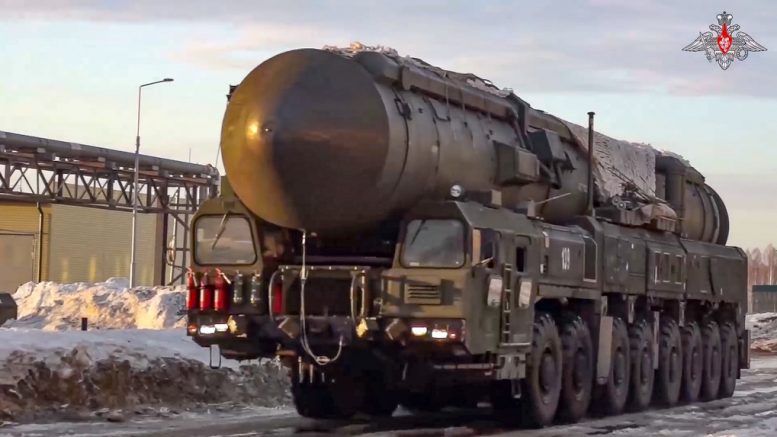MOSCOW (AP) — A senior Russian diplomat said Wednesday that Moscow will no longer inform the U.S. about its missile tests, an announcement that came as the Russian military deployed mobile launchers in Siberia in a show of the country’s massive nuclear capability amid the fighting in Ukraine.
Russian Deputy Foreign Minister Sergei Ryabkov said in remarks carried by Russian news agencies that Moscow has halted all information exchanges with Washington after previously suspending its participation in the last remaining nuclear arms pact with the U.S.
Along with the data about the current state of the countries’ nuclear forces, the parties also have exchanged advance warnings about test launches. Such notices have been an essential element of strategic stability for decades, allowing Russia and the United States to correctly interpret each other’s moves and make sure that neither country mistakes a test launch for a missile attack.
The termination of missile test warnings appears to mark yet another attempt by Moscow to discourage the West from ramping up its support for Ukraine by pointing out at Russia’s massive nuclear arsenals. It comes days after Russian President Vladimir Putin announced the deployment of tactical nuclear weapons to Moscow’s ally Belarus.
Last month, Putin suspended the New START treaty, charging that Russia can’t accept U.S. inspections of its nuclear sites under the agreement at a time when Washington and its NATO allies have openly declared Russia’s defeat in Ukraine as their goal.
Moscow emphasized that it wasn’t withdrawing from the pact altogether and would continue to respect the caps on nuclear weapons the treaty set.
The Russian Foreign Ministry initially said Moscow would keep notifying the U.S. about planned test launches of its ballistic missiles, but Ryabkov’s statement reflected an abrupt change of course.
“There will be no notifications at all,” Ryabkov said in remarks carried by Russian news agencies when asked if Moscow would also stop issuing notices about planned missile tests. “All notifications, all kinds of notifications, all activities under the treaty. will be suspended and will not be conducted regardless of what position the U.S. may take.”
Ryabkov’s announcement followed U.S. officials’ statement that Moscow and Washington have stopped sharing biannual nuclear weapons data that were envisaged by the New START treaty. Officials at the White House, Pentagon and State Department said the U.S. had offered to continue providing this information to Russia even after Putin suspended its participation in the treaty, but Moscow informed Washington that it would not be sharing its own data.
The New START, which then-Presidents Barack Obama and Dmitry Medvedev signed in 2010, limits each country to no more than 1,550 deployed nuclear warheads and 700 deployed missiles and bombers. The agreement envisages sweeping on-site inspections to verify compliance.
The inspections have been put on hold since 2020 because of the COVID-19 pandemic. Discussions on resuming them were supposed to have taken place in November 2022, but Russia abruptly called them off, citing U.S. support for Ukraine.
As part of the Russian drills that began Wednesday, Yars mobile missile launchers will maneuver across three regions of Siberia, Russia’s Defense Ministry said. The movements will involve measures to conceal the deployment from foreign satellites and other intelligence assets, the ministry said.
The Defense Ministry didn’t say how long the drills would last or mention plans for any practice launches. The Yars is a nuclear-tipped intercontinental ballistic missile with a range of about 11,000 kilometers (over 6,800 miles). It forms the backbone of Russia’s strategic missile forces.
The Defense Ministry released a video showing massive trucks carrying the missiles driving out from a base to go on patrol. The maneuvers involve about 300 vehicles and 3,000 troops in eastern Siberia, according to the ministry.
The massive exercise took place days after Russian President Vladimir Putin announced a plan to deploy tactical nuclear weapons to Belarus, Russia’s neighbor and ally.
Tactical nuclear weapons are intended for use on the battlefield and have a relatively short range and a much lower yield compared to the long-range strategic missiles fitted with nuclear warheads that are capable of obliterating whole cities.
Putin’s decision to put the tactical weapons in Belarus followed his repeated warnings that Moscow was ready to use “all available means” — a reference to its nuclear arsenal — to fend off attacks on Russian territory.
Ryabkov said Wednesday that Putin’s move folllowed the failure by the West to heed previous “serious signals” from Moscow because of what he described as the “fundamental irresponsibility of Western elites before their people and international security.”
“Now they will have to deal with changing realities,” he said, adding: “We hope that NATO officials will adequately assess the seriousness of the situation.”
Russian officials have issued a barrage of hawkish statements since their troops entered Ukraine, warning that the continuing Western support for Ukraine raised the threat of a nuclear conflict.
In remarks published Tuesday, Nikolai Patrushev, the secretary of Russia’s Security Council, which Putin chairs, sternly warned the U.S. and its allies against harboring hopes for Russia’s defeat in Ukraine.
Patrushev alleged that some American politicians believe the U.S. could launch a preventative missile strike on Russia to which Moscow would be unable to respond, a purported belief that he described as “short-sighted stupidity, which is very dangerous.”
“Russia is patient and isn’t trying to scare anyone with its military superiority, but it has unique modern weapons capable of destroying any adversary, including the United States, in case of a threat to its existence,” Patrushev said.






































